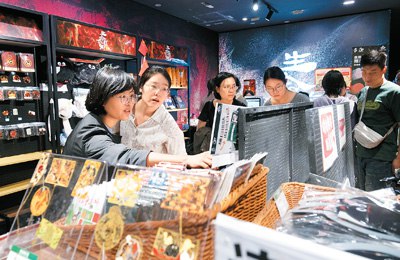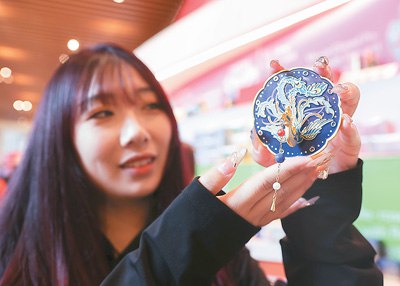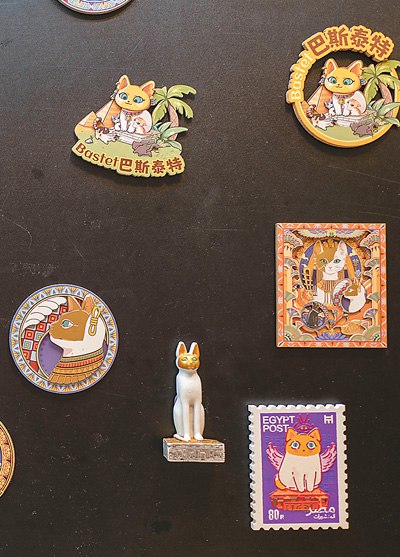




- BRNN
- BRI News
- BRNN News
- Database
Official Documents Polices and Regulations
Inter-government Documents International Cooperation BRI Countries
Business Guide Economic Data BRI Data
Trade
Investment Projects Latest projects
Cases - Content Pool
Driven by the "museum craze" sweeping across China, creative cultural products launched by museums have gained popularity, especially among young people.
With more than 5,000 years of history, China is renowned for its rich and diverse culture. Museums nationwide are leveraging their unique collections to develop appealing cultural products as more tourists choose to visit.

Tourists select creative cultural products at the Hunan Museum in central China's Hunan Province. (Photo/Lin Daohui)
The Palace Museum, for example, established the Palace Museum Cultural Innovation Center in 2008 and has since excelled in producing sought-after creative cultural products.
From calendars to lipsticks, stationery, and ornaments, the Palace Museum's offerings resonate with consumers looking to incorporate a touch of history into their daily lives.
This success has sparked a ripple effect across the country's museums. The Henan Museum in Zhengzhou, central China's Henan Province, made headlines with its archaeological blind boxes, where miniature replicas of artifacts are "buried" for customers to excavate.
Meanwhile, the Gansu Provincial Museum in Lanzhou, northwest China's Gansu Province, transformed its iconic bronze sculpture, "Galloping Horse Treading on a Flying Swallow," into charming plush toys, resulting in a surge in sales.

A visitor displays a creative cultural product inspired by an exquisitely delicate empress crown from ancient China at the National Museum of China. (Photo /Chen Xiaogen)
"A well-designed piece of creative cultural product not only showcases a museum's cultural essence, academic achievements, and cultural value, but it also demonstrates the museum's operational excellence," said Fang Xiaotian, a lecturer at the School of Journalism and Communication at Minzu University of China.
Fang added that high-quality creative cultural products satisfy visitors' cultural cravings while promoting the cultural concepts and values behind them, helping to boost museum revenue.
The National Museum of China (NMC) recently achieved great success with its fridge magnet inspired by an exquisitely delicate empress crown from ancient China. In just three months since its launch, nearly 80,000 fridge magnets have been sold.
Fridge magnets are particularly popular among young people. "They are beautifully designed and carry historical significance," said Han Zhiru (pseudonym), an avid museumgoer who works in Beijing.

Photo shows fridge magnets from the exhibition "On Top of the Pyramid: The Civilization of Ancient Egypt" at the Shanghai Museum. (Photo/Wang Chu)
Han has visited several notable museums, including the Sanxingdui Museum in Guanghan, southwest China's Sichuan Province, the Hubei Provincial Museum in central China's Hubei Province, and the Hunan Museum in central China's Hunan Province.
Creative cultural products bring cultural relics to life and contribute to cultural inheritance. These products are designed to capture the attention of young consumers, sparking their interest in the deeper historical and cultural significance behind artifacts, Fang said.
Attractive creative cultural products that embody cultural significance cater to young people's desire for entertainment and culture, as they often have strong emotional connections to China and confidence in Chinese culture, Fang added.
The demand for creative cultural products has yielded tangible benefits for museums. For instance, the NMC's fridge magnet has boosted sales of the entire series of empress crown memorabilia, generating total revenue exceeding 10 million yuan ($1.38 million).
Meanwhile, the exhibition "On Top of the Pyramid: The Civilization of Ancient Egypt" at the Shanghai Museum generated 80 million yuan in sales of creative cultural products within two months, stimulating over 1 billion yuan in related spending.
In recent years, companies like Pop Mart and MINISO have successfully blended Chinese cultural elements into their products, achieving impressive global sales.
"Museums can take a page from their playbook to launch creative cultural products by incorporating elements from various cultures into innovative designs. This approach can showcase Chinese culture, promote cultural exchanges and mutual learning, and help the world better understand China and its rich heritage," Fang noted.

Tel:86-10-65363107, 86-10-65368220, 86-10-65363106